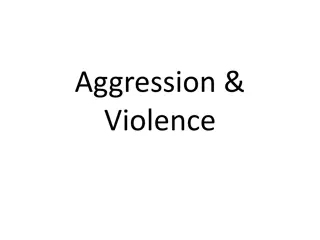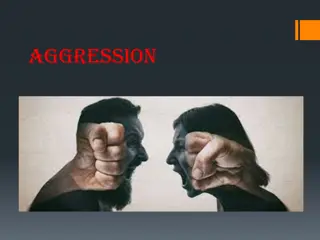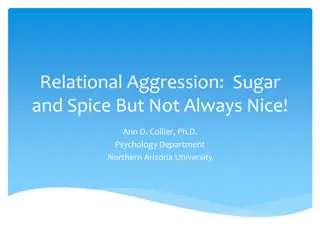Insights into Aggression: Causes, Gender Differences, and Influencing Factors
Aggression is intentional behavior aimed at causing harm, with instrumental and hostile forms. Gender differences show males are more physically aggressive, while females engage in relational aggression. Aggression is influenced by situational and cultural factors, with influences from alcohol. Understanding these factors is crucial in addressing and preventing aggressive behavior.
Download Presentation

Please find below an Image/Link to download the presentation.
The content on the website is provided AS IS for your information and personal use only. It may not be sold, licensed, or shared on other websites without obtaining consent from the author.If you encounter any issues during the download, it is possible that the publisher has removed the file from their server.
You are allowed to download the files provided on this website for personal or commercial use, subject to the condition that they are used lawfully. All files are the property of their respective owners.
The content on the website is provided AS IS for your information and personal use only. It may not be sold, licensed, or shared on other websites without obtaining consent from the author.
E N D
Presentation Transcript
Aggression Chapter 12
What is Aggression? Intentional behavior aimed at doing harm or causing pain to another person Instrumental aggression Aggression as a means to some goal other than causing pain Hostile aggression Aggression stemming from feelings of anger and aimed at inflicting pain
Gender Differences in Aggression Gender differences = Males more aggressive According to evolutionary theory: Males behave aggressively to secure status Female choose male who offers greatest protection and resources Males aggress "jealously" To ensure their paternity Testosterone Greater testosterone linked to greater aggression Correlational findings, not causal
Gender Differences in Aggression Gender differences Males More physical aggression Females More relational aggression Gossiping, backbiting, spreading false rumors Gender similarities Response to provocation
Aggression is Influenced by the Situation Aggression is an optional strategy Capacity for aggression exists Expression of aggression Circumstances Culture Changing social conditions can change behavior. Aggressiveness increases as competition increases
Aggression is Influenced by Culture Among Southern, white males, argument- related homicide rates are higher, especially in rural areas This group tends to endorse violence for protection and in response to insults
Aggression Occurs in Families 49% of violent family crimes were against spouses 84% of victims were women Eight in 10 murderers of family members were male Physical abuse Highest in cultures that regard male abuse as a right Honor killings
Alcohol Increases Aggression Alcohol increases aggression. This link is well-documented. Why? 1. Reduces inhibitions 2. Disrupts information processing 3. "Think drink" effect Expectations about the effects of alcohol influence behavior more than amount of alcohol drunk!
Factors Increasing Aggression Pain Increases aggression Discomfort Increases aggression Heat, humidity, air pollution, and offensive odors
Frustration & Aggression Frustration-Aggression Theory The idea that frustration the perception that you are being prevented from attaining a goal increases the probability of an aggressive response. Goal proximity Closer to goal = more frustration E.g., someone cuts in line More frustration = more aggression Unexpectedness of frustration More unexpected = more aggression
Frustration & Aggression Frustration Does not always lead to aggression Increases anger & readiness to aggress Frustration aggression link depends on: Size/strength of the person who frustrated you Person s proximity & ability to retaliate Likelihood of aggression is reduced when frustration is: Understandable, legitimate, and/or unintentional
Relative Deprivation Relative (not absolute) deprivation is linked to frustration and aggression. People perceive a discrepancy between what they have and what they think they should have.
Provocation & Aggression When provoked with aggression People may reciprocate with aggression Will not reciprocate Provocation was unintentional Mitigating circumstances Must be known at the time of the provocation
Aggressive Stimulus Aggressive Stimulus An object that is associated with aggressive responses and whose mere presence can increase the probability of aggression
Learning to be Aggressive Social Learning Theory The idea that we learn social behavior (e.g., aggression) by observing others and imitating them. Research Question Will watching an aggressive model cause children to behave aggressively?
Banduras Bobo Doll Experiments IV = Child s exposure to aggressive model Aggressive model: Adult knocks around, hits, hammers, a plastic, air-filled Bobo doll Control condition: No exposure to aggressive model DV = Child s observed aggression Results Children imitated the aggressive adults. Treated the doll in an abusive way Imitated exact actions of adult Children in a control condition Almost never showed aggression
Media Violence Watching violence Most research indicates it increases aggression, angry and hostile thoughts Playing violent video games Even stronger influence on aggression Exposure to media violence Increases physiological arousal and excitement Triggers tendency to imitate violent characters Primes aggressive ideas and expectations Social scripts: Ways of behaving socially that we learn implicitly from our culture
Media Violence Repeated exposure to media violence is associated with: Decreased sensitivity to violence Less physiological arousal Less reactivity to real-life aggression Indifference to violence Reduced sensitivity to needs of others
Media Violence Watching more TV violence in childhood Associated with more violent behavior in adolescence and adulthood Longitudinal Study of 700 families, 17 years TV watching in adolescence predicted violence against others in adulthood
Media Violence Elementary school children Viewing more media violence at beginning of school year predicted more aggression, less pro-social behavior at end of year Heavy television viewers Have exaggerated view of the degree of violence in world Greater fear of being personally assaulted Experiments and longitudinal research Viewing violence has strongest effects on those already inclined to violence Gives permission to express negative inclinations
Sexual Violence against Women 85% of all rapes or attempted rapes are acquaintance rape. When women know their assailant, may not label it as rape College women s definitions of rape Forced intercourse with an acquaintance or stranger Being molested as a child If drunk, drugged, or assaulted by boyfriend, less likely to label as rape
Confusion/Miscommunication about appropriate Sexual Behavior Sexual scripts Traditional female role Resist the male s sexual advances Male s role Be persistent Almost 100% of high school students agree: A man should stop sexual advances as soon as a woman says no. But half of those students believe that when a woman says no, she doesn t always mean no
How Do You Reduce Aggression? Conventional wisdom suggests that one way to reduce feelings of aggression is to do something aggressive. Get it out of your system has been a common piece of advice. This common belief is based on an oversimplification of the psychoanalytic notion of catharsis. This does not work
How Not to Control Aggression Does watching aggressive games reduce aggressive behavior? NO! Watching aggression increases aggression. Does direct aggression against the source of your anger reduce further aggression? Again, the answer is NO! Participants who inflicted psychological or physical harm on an innocent person: Derogated their victims Convinced themselves victim deserved what they got Makes it easier to do further harm to the victim in the future
Then, how do you control aggression? Control anger by actively enabling it to dissipate. Use simple devices. Count to 10. Take deep breaths. If close friend or spouse makes you angry, expressing anger may allow you to: Gain insight into yourself and dynamics of the relationship If anger is: Non-violent and Non-demeaning
Then, how do you control aggression? To reduce aggression Take responsibility Apologize Indicate it is unlikely to happen again Oops! My bad! Modeling works with nonaggressive behavior. When children see adults express themselves in calm, respectful manner after provocation Children handle own frustrations with less aggression
Then, how do you control aggression? Those who lack skills often react aggressively Formal training can reduce aggression Taking the perspective of the aggressor reduces aggression Harder to aggress when one feels a personal connection with a person Empathy is a skill that can be taught























